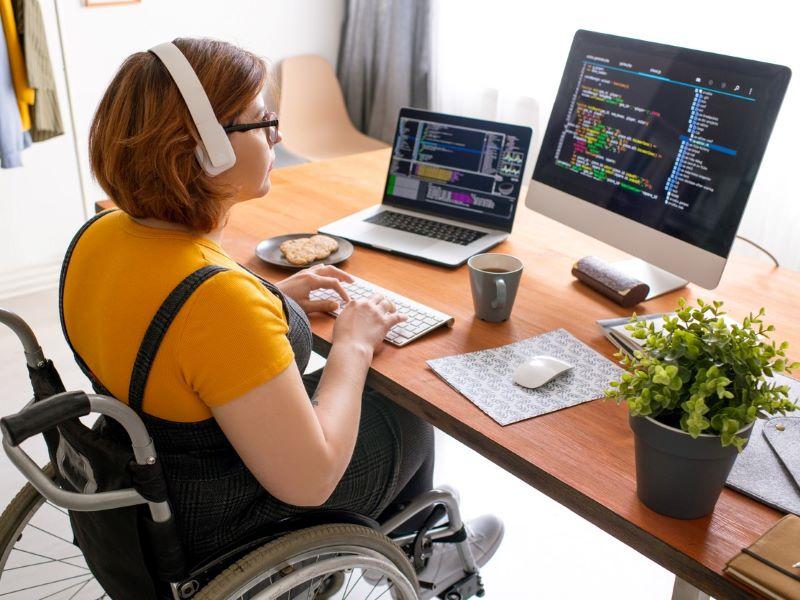Given the increase in the number of students and staff declaring disabilities (and the fact that many won’t), it’s critical that senior leaders build inclusive universities. The only way they can do this is by working collaboratively with their students and staff.
The first part of my series on how senior leaders can ensure their institution is disability inclusive discussed gaining feedback from disabled students and staff, increasing accessibility and ways to approach language around disability. The second part delves into how to co-create a university strategy, manage workloads and make promotion processes more equitable.
Co-create or consult on your university strategy and strategic changes
Our strategy at De Montfort University (DMU), The Empowering University, involved input from staff, students and partners. There are four key pillars to this strategy: empowering people, partnerships with purpose, learning for life and knowledge creation. Through consultation, DMU had input from those who would be affected early in the process, which informed the strategy.
You can gain feedback on strategies and strategic changes in a variety of ways, including via focus groups and surveys with students, staff and key partners. You should communicate your plans with everyone who is likely to be affected as you go along, making it an iterative and interactive process. This method allows you to take people with you on your strategy journey and enables you to see any barriers for certain groups early on. For example, if you are making changes to teaching methods, you will need to ensure that any new approach is suitable for all student cohorts and, as you progress through the changes, you need to keep gaining feedback and make changes as required.
Consider student and staff workloads
Heavy workloads have been an issue in academia for many years. However, it is not just the amount of work that is the problem. Heavy workloads are also a result of the way assessment is structured. DMU has recently moved to block teaching as part of its Education 2030 strategy. With block teaching, each student focuses on a single module at a time. They complete that module and its assessments, then move on to the next one. This means students are not balancing multiple assessments across multiple modules simultaneously, which makes it easier for them to manage their work, especially if they have other commitments such as caring responsibilities or jobs, or if they have disabilities. When senior leaders consider how they structure courses and assessment, they can support all students.
Here are some tips:
- Avoid clustering assignments together
- Balance workloads between modules
- Consider how periods of student absence are managed
- Consider online teaching options for those who can’t attend in person.
When it comes to supporting disabled staff, consider staggering marking. For instance, giving a staff member two sets of 30 essays to mark might be a better option than one set of 60 essays.
You could also ask disabled staff how long it takes them to complete certain tasks and allocate them additional time to reflect this. For example, students with dyslexia can get 25 per cent extra time in university exams, so perhaps you could give 25 per cent extra time to staff with dyslexia for marking assignments.
- Resource collection: Routes to improving disability support in higher education
- Making conferences more inclusive: opportunities, barriers and lessons learned
- Rejecting hybrid conferences as the new norm reeks of ableism
Consider the equitability of your internal promotion processes
Internal promotion processes provide opportunities for staff development, but you need to consider whether yours are equitable. Some practical tips include:
- Have consistent promotion criteria that do not change every one to two years. Making regular changes to promotion criteria means people do not have enough time to meet them and then apply before a change is made
- Consider the timing of your promotion processes and how much time you give staff to apply. Giving staff a month to six weeks to apply means they have more time and can seek any support if needed. Further, asking staff to apply at busy times of year will mean they have to balance multiple demands
- Consider the opportunities you are giving to staff to meet those promotion criteria
- As part of your appraisal process, discuss with staff where they see themselves going in their careers and help them focus on finding opportunities to enable relevant development and progress.
Give consideration to what you want senior teams of the future to look like. If you are not recruiting a diverse range of staff to leadership positions, your institution will lack a critical, wider perspective that is reflective of the student population.
Students and staff with disabilities might face additional challenges in higher education institutions, but they can also be more adaptable, having spent their lives finding strategies to work around their disabilities and fit into a world that was not designed for them. It is critical for senior leaders to be aware of this and be willing to engage in conversations and collaborations with disabled students and staff to create more equitable university experiences.
Meredith Wilkinson is a senior lecturer in psychology at De Montfort University.
If you would like advice and insight from academics and university staff delivered direct to your inbox each week, sign up for the Campus newsletter.




comment